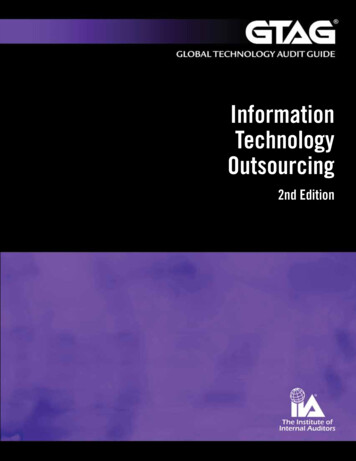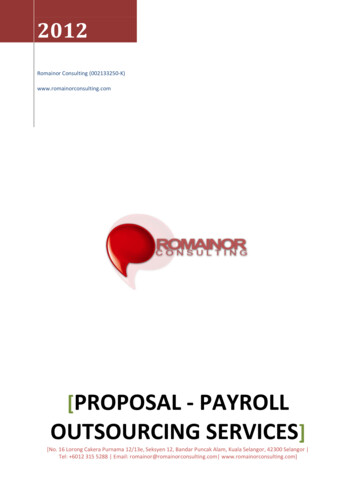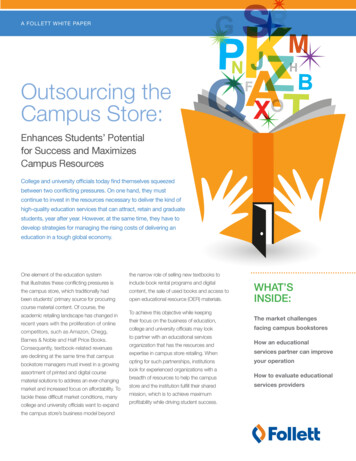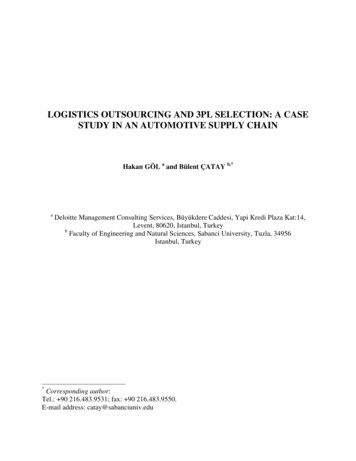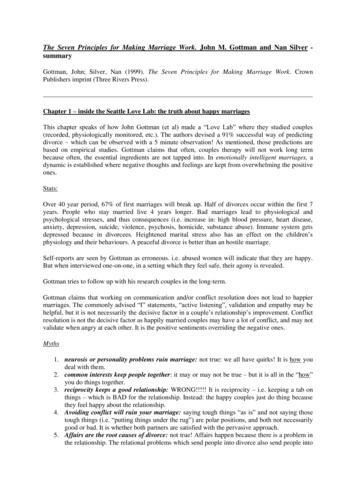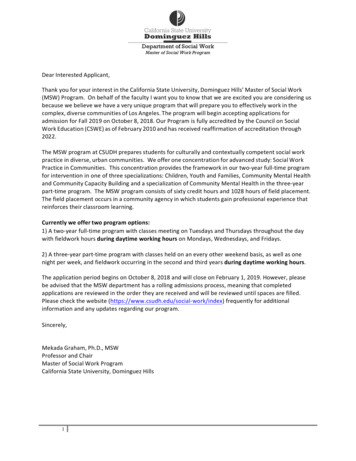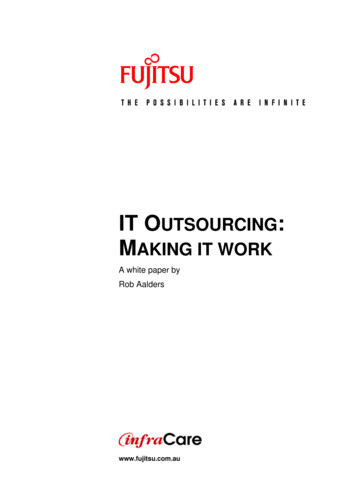
Transcription
IT OUTSOURCING:MAKING IT WORKA white paper byRob Aalderswww.fujitsu.com.au
CONTENTSABOUT THE AUTHOR4WHAT IS OUTSOURCING?5THE CURRENT STATE OF OUTSOURCING5The extent of outsourcing6Outsourcing pioneers6WHAT HAS GONE WRONG IN OUTSOURCING7Failure to take a strategic approach7Lack of experience7Absence of method7Micro management7Failing to understand the role of IT7Ignoring interrelationships8The people factor8Cost driven8And many others 8WHAT HAS GONE RIGHT IN OUTSOURCING8WHAT TO LOOK FOR IN SERVICE PROVIDERS11The importance of method11COMMON MISTAKES IN OUTSOURCING12THE COSTS OF OUTSOURCING13THE BENEFITS OF OUTSOURCING13Improvements that cannot be achieved by average IT units13Improved business processes14Better cost management controls14Quality of service15Keeps pace with the competition16Core competency focus16A valid way of achieving cultural change16Access to management qualities not found in IT departments17Flexibility in staff numbers17PAGE: 2 / 21IT OUTSOURCING: MAKING IT WORK
Quality staff17Access to specialist skills and knowledge18You can fire your outsourcer18DOING OUTSOURCING RIGHT18OUTSOURCING CHECKLIST19NEXT STEPS19RECOMMENDED READING20ABOUT FUJITSU21PAGE: 3 / 21IT OUTSOURCING: MAKING IT WORK
ABOUT THE AUTHORRob Aalders is the author of The IT Outsourcing Guide, which hasreceived worldwide acclaim. IT Week described it as an “instant classic”.The Australian Financial Review wrote “If it’s your job to manage anyaspect of information technology outsourcing you should buy thisbook”. Dr Mary C Lacity, Associate Professor of MIS at the University ofMissouri (US), and Dr Leslie P Willcocks of the University of Oxford (UK)both praised this book for its quality and practicality. Aalders is also theco-author of The IT Manager’s Survival Guide, to be published later thisyear.Rob Aalders had a notable career as a CIO and consulting strategist inthe UK, Asia and Australia. His clients included Qantas, Australia Post,Hong Kong Transport, TNT and Tyndall Australia.PAGE: 4 / 21IT OUTSOURCING: MAKING IT WORK
WHAT IS OUTSOURCING?Simply put, outsourcing is the contracting of a third party to manage abusiness process more effectively and efficiently than can be done inhouse. The purpose of this white paper is to review issues andopportunities offered by IT outsourcing. It identifies common errors madein outsourcing and factors that are critical to success.THE CURRENT STATE OF OUTSOURCINGOutsourcing is not a novel concept. Business processes such a fleetmanagement, printing and advertising have been contracted to externalsuppliers for decades. However, IT outsourcing is a relatively newpractice, despite some arguing it is similar to the computer bureauservices of the 1960s and 1970s. Key distinctions between then andnow include: The central role information that technology now plays in almostevery facet of business. The bureaux of the ‘60s and ‘70s largelyprocessed simple billing functions The advent of integrated applications, end-user computing,networking and distributed systems has created computerenvironments that are both complex and brittle. Early bureaux ranmonolithic mainframes with dumb terminals The fact that information technology is now central to the minute-tominute operation of the business. The systems of the 1960s and1970s performed back-room functionsA decision to outsource information technology processes now implies amuch heavier reliance on the quality of the service provided by theoutsourcer.Many large, sophisticated and successful corporations have followed theoutsourcing path with spectacular success.A few others have discovered the hard way that outsourcing can be acomplex process, fraught with difficulty. Some of these companiesretreated from outsourcing and tried to bring their systems back inhouse. They discovered that reversing the process is not simple, as theystill lack both skills and resources.Outsourcing can be a spectacular success if it’s done for the rightreasons, follows due process, and is pursued with realistic expectationsand a clear understanding of where the benefits are likely to emerge.PAGE: 5 / 21IT OUTSOURCING: MAKING IT WORK
The extent of outsourcingThe size of the worldwide outsourcing industry was estimated byresearch organisation Dataquest to be more than US100 billion in 2001and growing at 20 percent per annum. Some Australian analystsestimate the proportion of large to medium enterprises outsourcing ITfunctions will have grown from around 25 percent in 1997 to more than50 percent by 2001.A survey1 of the London Stock Exchange FTSE Index over a period ofthree years found a generally positive relationship between high levels ofoutsourcing and enhanced stock market performance. This does notprove that outsourcing and performance are directly related, but it doessuggest well-run companies see outsourcing as a sound managementpractice.The fact is that outsourcing is here to stay, and those that use it mosteffectively will reap the benefits of their foresight and good management.Outsourcing pioneersIn outsourcing, the old observation that pioneers get arrows in theirbacks rings true. The pioneers who managed the first generation ofoutsourcing projects learned many harsh lessons. Among them were: The importance of following a sound process in selecting theprovider and forming the contract The critical role played by the service provider’s infrastructuremanagement methodology – or lack of it The importance of developing an appropriate focus on costs andbenefits, and understanding how benefits may emerge The need for both parties to dedicate resources to properly managethe relationship The need for new incentive models that reward both individuals andorganisations for success Understanding that failure is always a joint responsibilityAbove all, the first generation learned that outsourcing selections drivenby price alone would almost certainly lead to tears and disappointment.1Zaple A, Successful Outsourcing and Contract Management, Presentation, May 1999PAGE: 6 / 21IT OUTSOURCING: MAKING IT WORK
WHAT HAS GONE WRONG IN OUTSOURCINGSome early outsourcing arrangements were unsuccessful for a numberof reasons, including:Failure to take a strategic approachSome failed to approach outsourcing as a strategic decision. “Know yourmotives!”, said one CEO2, and ensure you have a strategy to drive youroutsourcing project. Nearly all the evidence points to the importance ofensuring that the decision to outsource is made with a strategicperspective and associated with clear goals and objectives.Lack of experienceThe pioneers lacked experience, frameworks, and methods foroutsourcing. Contracts, service level agreements, risk management,performance agreements and resource management methods grewfrom trial and error. Today there is a plethora of experienced consultantsand enterprises to help steer the novice around the dangers.Absence of methodSome early outsourcers lacked formal or testable means for deliveringservices. Today, companies such as Fujitsu and Microsoft have investedheavily in introducing formal methods such as the IT InfrastructureLibrary (ITIL) for best practice in managing IT services.Micro managementSome pioneers over-managed the service provider. US-basedoutsourcing authority Peter Bendor-Samuel3 reported on a company thateven prevented the outsourcer using its best practice methodology, withdismal results. Leave managing the inputs to the outsourcer.Failing to understand the role of IT"Organisations fail when they hand over IT without understanding its rolein the organisation, and what the vendor's capabilities are," said authorsLacity and Willcocks4. Some companies failed to understand that IT nolonger simply supports mission critical business processes – it is one!2Wilkins M, Royal & Sun Alliance, Personal communication, Oct 20003Paul LG, CIO magazine, IDG Communications, Sydney, Spring 20014Lacity MC & Willcocks LP, Information Technology Outsourcing - Practices, Lessonsand Prospects, ASX Perspective, April 1999, p. 44-49PAGE: 7 / 21IT OUTSOURCING: MAKING IT WORK
Ignoring interrelationshipsDependencies between various business processes and between IT andbusiness processes are often tightly woven. Some failed to understandthis and suffered accordingly.The people factorOne manager5 observed that “Outsourcing can be pretty awful for ITstaff. They are squeezed by their new employer for whom they may feellittle attachment and then the customer, their old employer, squeezesthem”. Some pioneers gave insufficient attention to people issues.Cost drivenThe selection of the cheapest supplier, regardless of competence, was amistake. Outsourcing is about improving effectiveness and efficiency.Revenue growth and savings may emerge downstream in the business.Some pioneers adopted a narrow view of cost reduction based on anoften dubious IT budget that confused direct, indirect, variable, fixed andmarginal costs and was naïve in forecasting effects on revenue.And many others The list is considerable and includes other failings such as inflexiblecontracts, inadequate service level agreements, confrontationalmanagement practices and a failure to appreciate that improvinginformation technology services can be a long, slow haul.WHAT HAS GONE RIGHT IN OUTSOURCINGLots! The table6 below illustrates the high percentage of organisationsthat have rated their decision to outsource as positive. Note that the sum5Kovari N, Personal communication, October 20006This and other tables in this document are composite tables. They illustrate averagedscores taken by separate organisations using differing scales, techniques andmeasures. Composite tables are approximations and independent measurements byother consulting firms may lie above or below these averages. Principal sourcesinclude:- Karpathiou V & Tanner K, Information Technology Outsourcing in Australia RMIT,Melbourne 1993/94- PA Consulting Group, Strategic Sourcing Survey 1998, Melbourne 1998- Greaver M, Strategic Sourcing, American Management Association Intl, New York1999- Gay CL & Essinger J, An Insider’s Guide to Managing Strategic Sourcing, NicholasBrearley, UK 2000PAGE: 8 / 21IT OUTSOURCING: MAKING IT WORK
of those both ‘Satisfied’ (roughly 38%) and ‘Very satisfied’(approximately 42%) totals to around 80 percent.A good proportion of those surveyed rated their satisfaction very high.The reasons for this satisfaction are outlined in the table below.Analysts report a continuing trend for companies to rate ‘freeingmanagement time’ very highly. A survey7 by a major consulting group in1998 reported this as the highest scoring item both in Australia andoverseas. It is likely this displays a growing awareness of the strategic- Lacity MC & Willcocks LP, Global Information Technology Outsourcing, John Wiley &Sons Ltd, UK 20017Strategic Outsourcing Survey 1998, PA Consulting Group, 1998PAGE: 9 / 21IT OUTSOURCING: MAKING IT WORK
value of outsourcing in allowing managers more time to focus on theircore business.Other researchers have cited the following reasons why companiescontinue to outsource: Taking the IT function to a level of competence higher thanachievable in-house Facilitating best practice and best-of-breed implementation Leveraging ‘business critical’ infrastructure Extending global reach and standardisation of IT Converting fixed costs to variable costs Disposing of overvalued assets Reducing procurement management costs Improved service levels to both customers and staffLater in this paper other benefits are explored in more detail. It issufficient to note at this stage that despite some bad press, wellmanaged outsourcing works.One source of bad press has been the review of the AustralianCommonwealth whole-of-government outsourcing project. This report8identified cultural problems and resistance to change as key issues. CIOmagazine9 reported “According to Fahey [then the Finance Minister] andHumphry, the government was forced to impose its whole-ofgovernment approach on uncooperative agency heads because theywere wilfully blocking the government’s initiative to outsource thebureaucracies’ needs”.Auditor General PJ Barrett, commenting on the Humphry report in arecent article10, listed some of the benefits arising from outsourcing asbeing: Improvements in the transparency and consistency of decisions overtime, and Contributions to cost-effective outcomesThe Auditor General’s own report11 is often positive about the whole-ofgovernment project. Sadly, for many journalists good news is not newsand the positives received little mention in the press.8Humphry R AO, Review of the Whole-of-Government Information TechnologyOutsourcing Initiative, Commonwealth of Australia, 20009Bushell S, CIO magazine, IDG Communications, Sydney, Spring 200110Barrett PJ, CIO magazine, IDG Communications, Spring, Spring 2001PAGE: 10 / 21IT OUTSOURCING: MAKING IT WORK
WHAT TO LOOK FOR IN SERVICE PROVIDERSNot all service providers are created equal. Some important criteria toseek include: Appropriate outsourcing experience and proven customersatisfaction Sound formal best practice processes such as ITIL Standard design and implementation methodology Adequate numbers of appropriately skilled resources Industry leading technologies that are integrated into their processes Sound financial performance and backing Scale and geography to match your organisation’s needs Preparedness to be flexible locally without dropping standards Appropriate frameworks for service level management Cultural fit as widely differing cultures will lead to confrontation Commitment to continual improvement in their business Strong transition experience and human resource transition skills Clear vision of its role in leveraging your business The appropriate motivation to enhance your businessThe last criterion is important. You must understand why the outsourcerwants your business and what their goal is for the outsourcing program.The importance of methodFormal method is a ‘must have’ in two critical areas: Systems development. This is rarely an issue as major consultingcompanies usually adhere to formal systems developmentmethodologies Operations and service level management. Conversely, many willlack formal methods for this critical part of infrastructuremanagement that keeps your business runningIf the service provider cannot show that it has formal methods formanaging your information technology operations, then you hand overyour IT to people flying by the seat of their pants.11The Auditor General, Audit Report No.9, 2000-2001, Implementation of the Whole-ofGovernment Information Technology Infrastructure Consolidation and OutsourcingInitiative, Commonwealth of Australia 2000PAGE: 11 / 21IT OUTSOURCING: MAKING IT WORK
It is critical that you ask your service provider “How will you do thesethings?” Do not fall for sales spruik about what can be done. You mustalso determine how it will be done.COMMON MISTAKES IN OUTSOURCINGCommon mistakes in outsourcing include: Failing to properly determine the motives, goals and objectives ofoutsourcing Concentrating on cost reduction rather than benefits and the valueadded Sub-standard corporate governance of the outsourcing program overtime Failure to appoint staff to manage the relationship and contract Mishandled communications to staff, customers and otherstakeholders Inadequate incentive models that fail to motivate both individuals andthe corporate entity on both sidesThe following illustrates a number of tensions that arise in outsourcingagreements:Operational flexibility Contract adherenceCost and capital Infrastructure upgradesProject duration Technical qualityManaging the customer Managing the outsourcerLocal contract malleability Global corporate policyFormal methodology Extenuating circumstancesOutsourcer goals Customer goalsCustomer culture Outsourcer cultureMany of these tensions can be greatly reduced or removed by followinga sound selection and contract formation process. Standards Australiapublishes an excellent reference titled HB 240:2000 Guidelines formanaging risk in outsourcing utilizing the AS/NZS 4360 process.PAGE: 12 / 21IT OUTSOURCING: MAKING IT WORK
THE COSTS OF OUTSOURCINGMost researchers have given considerable attention to the costs ofoutsourcing. Those new to the field might be surprised to find that manypeople argue – as Lacity & Willcocks12 do – that cost savings are nolonger a major reason for outsourcing. Indeed, this duo draws attentionto the fact that an over-tight focus on costs, coupled to negligible profitmargins for the outsourcer, can constrain business flexibility. Costs inoutsourcing projects will typically rise in the early years as staff aretransitioned, entropic systems stabilised, proper procedures andmethods implemented and aged hardware replaced. There may befurther costs for acquiring proper systems management and networkmanagement tools, as well as the initial overheads of contractmanagement.In the long term the costs are likely to stabilise and then reduce incomparison to what they might have reached without outsourcing. Lacityand Willcocks (ibid.) noted that “Economic efficiency has more to do withIT practices than the inherent economics of scale”. It is probable thatoutsourcing leads to investment in enterprise architectures, plans,process and systems management tools that in turn lead to the savingsreported by most of the researchers named in this report.THE BENEFITS OF OUTSOURCINGThe benefits of outsourcing are many. A number of them are explainedbelow.Improvements that cannot be achieved by average ITunitsA consultant13 has noted that “One thing that outsourcing all or part of anIT shop forces upon an organisation is the definition of the outputsrequired, service levels and formal processes for the definition ofrequirements and change”.Outsourcing is a useful tool for bringing about this oft needed culturalchange.12Lacity MC & Willcocks LP, Global Information Technology Outsourcing, John Wiley &Sons, UK 200113Zaple A, The Keys to Outsourcing Success, Discussion Paper, 1998PAGE: 13 / 21IT OUTSOURCING: MAKING IT WORK
Improved business processesThe introduction of method and rigour in IT processes tends to flow on tothe business processes. Outsourcers encourage business managedbudget development and business controlled project expenditure. Theyencourage formal information technology investment proposals andprovide the skills in managing resultant change.Outsourcers make it easier for the business to manage IT effectively.They provide appropriate information and reports that ensureexpenditure, progress and issues are visible and controllable.Better cost management controlsHumphry’s report14 on the Commonwealth of Australia’s whole-ofgovernment outsourcing initiative noted that “There has been significantdebate about the extent to which savings have or have not accrued as aresult of the Initiative. While the Auditor General has commented uponthe savings, he has been very clear in his report, and in SenateEstimates hearings, that regardless of the methodology for calculation ofsavings, there are significant savings”.CIO magazine15 recently reported that “Commonwealth Auditor GeneralPat Barrett, too, while noting higher-than-expected costs resulted inlower-than-expected savings, fully accepted that savings had beenachieved”.A 1998 survey16 of companies reported most outsourcing initiativesresulted in cost reductions with “about 75% of respondents indicatingcost reductions of up to 20% of their annual budget”.Yet many will dispute that outsourcing cuts cost. This argument oftenfails to consider what IT costs would have risen to without outsourcing,or the burdens that ineffective IT has placed on the business.It is evident that in general outsourcing brings with it a tougher costmanagement regime, including: More rigorous controls over expenditure in general. The serviceprovider will normally face a tougher expense control regime than aninternal unit14Humphry R AO, Review of the Whole-of-Government Information TechnologyOutsourcing Initiative, Commonwealth of Australia, 200015Bushell S, CIO magazine, IDG Communications, Sydney, Spring 200116Strategic Outsourcing Survey 1998, PA Consulting Group, 1998PAGE: 14 / 21IT OUTSOURCING: MAKING IT WORK
Greater visibility over the true cost of IT. Outsourcing tends to bringto the surface the hidden costs of IT The service provider’s staff are used only when needed. AnandBarry17, Manager, Alliance Development, Fujitsu Services, hasarticulated this well, saying: “Flexible resourcing from the outsourcercan provide services that are available when needed, available whenexpanding or relocating, and not costing when not needed” Economies of scale from shared infrastructure, tools, utilities andspecialist skills Requests for additional IT staff are more closely argued, andapproval is limited to the project or task in question. The serviceprovider has to justify every one of its IT staff: it faces a zero basedbudgeting exercise every monthOutsourcing makes IT costs visible in a way that does not happen intraditional management reporting. All costs for manpower, supplies,maintenance and the like are identified and reported. This uncovering ofpreviously concealed cost tends to bring about a demand for tightercontrols.Yet you should not approach outsourcing as a tactical cost cuttingsolution; it must be a strategic decision. As Dr. Edward Lewis18 has said“Unless outsourcing is correctly selected and properly managed, there’sconsiderable potential for failure ”Quality of serviceThe dynamics of the outsourced environment are quite different fromthose in the internal environment. The outsourcer is a different economicentity with profit at risk.The service provider will strive to deliver quality, and if it is any good itwill have adopted or developed a rigorous, testable service deliverymethod such as the ITIL method.The service provider will also provide quality in output, partly fromimplementing the improved definitions of outputs, requirements andchange control, and partly from having staff with a higher level of skilland education than is found in many IT departments.17Barry A, Fujitsu Australia Limited, ICM Conference, Sydney, October 199918Bushell S, CIO magazine, IDG Communications, Sydney, Spring 2001PAGE: 15 / 21IT OUTSOURCING: MAKING IT WORK
Finally, the service provider will often drive improved quality in planningand budgeting. Poor planning and budgeting can damage its revenuesand profits.Keeps pace with the competitionMany companies face issues of capacity and capability in their internalIT unit. An outsourcer can generally provide resources reasonablyquickly. This allows you to acquire new systems or support businessactivities in a way that is not possible with a limited internal unit.The improved process and output quality will also add to competitivestrength. The controls that outsourcing brings with it tends to ensure thatsystems are built better.The service provider also will invest in state-of-the-art equipment andprocesses to provide the service, because that is its core business.Core competency focusSimply put, IT is a distraction for many managers. Business units oftenfind themselves micro-managing IT inputs. This issue is then oftencompounded by the need to exhaustively test IT outputs because ofpoor quality.IT is not a core competency for most businesses; the rise of outsourcingis an endorsement of this fact. Businesses are not very good at runningtheir IT. If they were there would be no need to consider outsourcing. ITmay be a core process, and others may run our core processes better.If the agreement is properly structured to focus on meeting businessobjectives through delivering outputs, then business managers are freedfrom managing IT and can focus on revenue generation instead.A valid way of achieving cultural changeChange is difficult to bring about and it requires a significant catalyst ortrigger.It is often frustration with the cultural issues that lie at the heart of ITissues of quality, deliverables and business responsibility. As the CEO ofa national organisation has observed19, “Outsourcing can be a valid wayof breaking a culture so that you can later bring an improved unit back inhouse”.19Graham V, National Rail Corporation, Personal communication, October 1999PAGE: 16 / 21IT OUTSOURCING: MAKING IT WORK
Outsourcing can act as a powerful bulldozer of change and this shouldbe regarded as a benefit.Access to management qualities not found in ITdepartmentsFujitsu’s Anand Barry20 stated in a conference presentation that“Outsourcing introduces discipline in defining and measuring servicelevels”. In other words: Services to be delivered are defined Measurement of these services is defined Data is collected and reported Trends are available for planning Efficiency comes from common management platformsAn audit of most internal IT shops will reveal very few define the servicesto be delivered and even fewer measure their success in deliveringthese services.Formal methodologies are often absent. The common argument from ITis that they have examined all the current ones and rejected them asthey lack flexibility, are overly detailed and onerous to follow. I suggestthe real reason for rejection is that methods would force the IT unit to doits work properly, demand an understanding of the underlyingcomplexities and introduce rigour where anarchy was once enjoyed.Outsourcing typically brings method, rigour and discipline to themanagement of information technology services.Flexibility in staff numbersCompanies often wind up with excess staff when major projects finish.Work swarms in to fill the gap, and the company carries a ‘hidden’ costfor a project well beyond its actual finish date.Service providers work on the consulting model. They own the pool oflabour. You just rent it when you want it, and when you do not want it,you send it back.Quality staffResearch organisation Gartner Group21 titled one of its articles ‘CIOAlert: A Wave of AD Incompetence Approaches’. The article warns of20Barry A, Fujitsu Australia Limited, ICM Conference, Sydney, October 1999PAGE: 17 / 21IT OUTSOURCING: MAKING IT WORK
staff with no formal education in IT– or at best with basic programmingtuition – migrating to IT careers. These people lack exposure to thebroad view of IT theory and best practices. Staff such as this are unlikelyto be hired by the better outsourcers.Consultancy firms and major outsourcing service providers tend to beattractive to graduates. Having hired them, these companies will ensurethe graduates are trained in a consistent and scientific method. Theythen bring a coordinated and cohesive approach to tasks. In contrast,the lack of consistent method in many internal IT departments provides alevel of coordination analogous to a seven-year-olds’ football team.Access to specialist skills and knowledgeLike medicine, information technology also has specialists. They may bedata architects, strategic planners, network designers or change controlspecialists, to name a few. Only the largest IT shops are likely to employthese people.A professional services company will have a pool of these peopleavailable to its customers. These skills are available to you whenneeded.You can fire your outsourcerYou can fire your outsourcer, but you cannot fire your IT department. Ido not encourage fear as a management tool, but I recognise a little of itgoes a long way.This is a large but still incomplete list of the benefits that can accruethrough outsourcing. There is only one benefit we do not argue for; thatoutsourcing reduces cost. Indeed the increased premium, if any, paid foroutsourced IT may be a good investment.DOING OUTSOURCING RIGHTDoing outsourcing right requires no magic or good luck. It does demandwhat Professor Fred Hilmer of the Australian Graduate School ofManagement22 described as “ the skilful application of sound andproven ideas to particular situations facing managers, not dogma, jargonor quick-fix fads”.21Gartner Group, Inside Gartner Group This Week Vol XV, No. 31, 4 August 199922AGSM, Managing People and Organisations (2000), AGSM, Sydney 2000PAGE: 18 / 21IT OUTSOURCING: MAKING IT WORK
OUTSOURCING CHECKLISTMany of the following questions are as applicable to establishedagreements as they are to a novice undertaking a first-time outsourcingproject: Do you know your real motives for outsourcing? Have you determined the most appropriate transition to outsourcingfor your business, for example big bang, piecemeal or incrementaltransition? Are your motives for outsourcing supported by matching goals andobjectives and are these goals and objectives realistic? Have you appointed a properly qualified group to undertake theprocess, including if necessary auditors, accountants, lawyers andproject managers? Do you know the full extent of your IT assets, including licences,people and equipment? Have you obtained measures of current performance of all affectedassets, people and processes? Does your RFP clearly reflect your goals and objectives foroutsourcing and will you be able to measure how well bidderscomply with those needs? Have you asked the bidders how they will achieve the goals you setfor outsourcing? Have you considered how you will manage the outsourcing contractand relationship over time? Have you fully developed a risk management plan for theoutsourcing agreement from inception to termination – for whateverreason?NEXT STEPSIf you are serious about outsourcing we recommend three immediatesteps: Inform yourself with background reading Talk to others that have outsourced. You may find an outsourcingspecial interest group or forum in your area Talk to established outsource providers and get their advicePAGE: 19 / 21IT OUTSOURCING: MAKING IT WORK
RECOMMENDED READINGA number of publications provide sound background on outsourcing,including: Aalders R, The IT Outsourcing Guide, John Wiley
information technology services can be a long, slow haul. W HAT HAS GONE RIGHT I N OUTSOURCING Lots! The table 6 below illustrates the high percentage of organisations that have rated their decision to outsource as positive. Note that the sum 5 Kovari N, Personal communication, October 2000 6
